Saint Jerome copying sacred texts(Cenni di Francesco di Ser Cenni)
Saint Jerome copying sacred texts – 1380-82
Some two decades have passed since the reappearance of this truly refined small panel by Cenni di Ser Cenni representing Saint Jerome sitting in his lavishly adorned scriptorium, copying sacred texts. With an expression of the highest intellectual energy, he glances at a text that he is about to copy into a large manuscript placed on his precious desk. On a wooden bench, placed upon the base of this massive desk, a young man, clad in the black habit of a jurist, may be seen. With a pen and ink char in his hands he seems to be assisting Jerome in the copying of a Bible. The coat of arms next to him shows a six-part golden mountain, crossed by a red diagonal beam, on what must have once been a blue ground. This heraldic device is undoubtedly the emblem of the noble Florentine Ridolfi family, inhabitants of the Oltrarno in Florence. Thus we have good reason to believe that this panel and, as we shall see, its companion panel with the Stigmatisation of Saint Francis in a French private collection (fig.2), were commissioned by a member of the Ridolfi family. As will be argued below this was their most famous offspring, Lorenzo di Antonio Ridolfi (1362-1442). At the time that this charming panel was first published in a catalogue of the Sarti Gallery (G. Sarti, Primitifs et Maniéristes Italiens (1370-1570), Paris 2000, pp. 14-223), the authors agreed to earlier verbal proposals expressed by Miklòs Boskovits and Filippo Todini and suggested an attribution to the Florentine painter Cenni di Francesco di Ser Cenni. This conclusion in favour of Cenni di Francesco’s authorship was presumably based not only on a stylistic analysis, but also because this painter had indeed created a comparable picture of the same subject in the Museo Diocesano in San Miniato al Tedesco (Pisa). Even though this latter panel was painted, it would seem, decades later (1411) and is of considerably larger dimensions, it is clearly rendered with a similar compositional arrangement. Nevertheless, there are some discernible differences in the style of these two paintings which, it would seem, are due to the fact that they were executed at two distinct moments in the artist’s career. The Jerome under discussion here reveals a style which is still markedly rooted in the art of a previous generation of Florentine painters, whereas the other painting in San Miniato (1411), marks the final moment in Cenni’s career when his art clearly had turned to a more linear style and to generally more slender forms of gothic elegance.
1
 2
2
Cenni di Francesco di ser Cenni’s retrospective vein, as it appears in our small painting, marks a particular moment in his career, when his works reveal a distinct awareness and a return to the aesthetic principles of an earlier generation of painters, such as Taddeo Gaddi, Orcagna and also Giovanni da Milano. This is also discernible in the small panel with the Stigmatisation of Saint Francis, formerly in a French collection (Paris, Drouot, March 18th 2011, lot 17) which, as we are going to demonstrate, originally formed part of the same diptych.
When, some eight years ago, I had occasion to examine this hitherto unpublished panel with the Stigmatization of Saint Francis (fig.2, 14) of exactly the same dimensions as the present painting, I was certain that both pictures had once belonged to the same unit, presumably a diptych. This identification was not only based on their dimensions and the identical tooling of the golden upper border in the shape of a stripe of rectangular quatrefoils, but also on the corresponding pictorial style. In both pictures the solid forms are rendered in the same manner, which is also true for the soft, well-articulated folds of the heavy, falling draperies which are carefully lit by intense light. In both paintings we encounter figures with characteristically pronounced facial features, which in the case of Jerome’s profile, with his piercing eyes, seem to recall qualities common to Orcagnesque formulas and those invented by Giovanni da Milano (fig.4, 8, 9).
Before we discuss the question of the painting’s chronological place within Cenni di Francesco di ser Cenni’s oeuvre, we should turn to an analysis of its particular iconography and function as a small diptych for private devotion, as well as a discussion of its possible patron. The decision, on behalf of the patron, to have united in his diptych the scenes of Saint Francis’ Stigmatization with a rather sophisticated depiction of Saint Jerome copying the Bible appears to be a rather unique and rare choice. Upon closer examination the depiction of Saint Jerome copying various texts under the vigilant eyes and ears of the patron himself, the young laureate in law appearing with a pen and ink char in his hands and an open book to write down Jerome’s words, must have been a deliberate and autobiographical option ordered by the patron, who, as is revealed by the emblem on his bench, was undoubtedly a member of the noble Florentine family Ridolfi. Should we be able to single out the patron of our panel among the many exponents of the famous Ridolfi in Florence, we would then have gained an important clue as to when the diptych could have been painted.
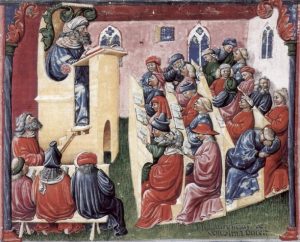
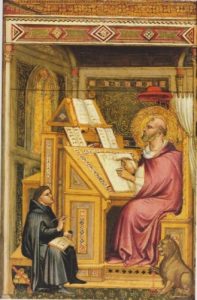
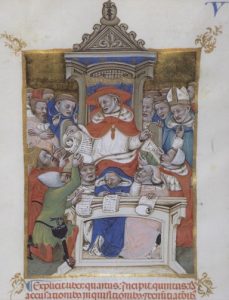 3a 3b
3a 3b
The association of the patron, apparently a young jurist from the Ridolfi family, with Saint Jerome in his study while he transcribes a text, seems to point to one particular member of the Ridolfi family, the well-known Lorenzo di Antonio Ridolfi. Lorenzo was later to become an important personality at the court of the Medici and of pivotal importance as an ambassador in the affairs of the Florentine alliance with Venice against Milan. Not only is Lorenzo di Antonio known to have been a jurist of renown, but he was also a fervent admirer of Saint Jerome. Vespasiano da Bisticci (1421-1496), a late contemporary of Ridolfi himself, describes him in his biography dedicated to Lorenzo di Antonio Ridolfi as ‘… essendo singularissimo dottore in iure civile e canonico, non lo volle esercitare parendogli ch’egli non si potesse fare con buona coscienza. Fu uomo di grandissimo consiglio, fu molto adoperato nella republica…’ (Vespasiano Florentino, Spicilegium Romanum Tomus I Virorum illustrium CIII qui saeculo XV extiterunt Vitae, Rome 1839, pp. 494-498). This alone would not have been sufficient to identify the patron of our diptych as Lorenzo di Antonio, had Vespasiano not particularly denoted Ridolfi’s great devotion for Saint Jerome: ‘Fu (Lorenzo Ridolfi) molto religioso e volto al divino culto, … Infra l’altre sua devozioni ch’egl’aveva era in Santo Girolamo, del quale si vede che diligentissimamente radunò tutte le epistole sua, ed avevane più numero lui che se ne trovasse in Italia e fuori. Vi sono alcune epistole della interpretazione del saltero e d’altre differenze di traslazioni dove sono molti testi grecie ed ebrei, i quali ha fatto mettere di mano d’ebrei e di mano di greci accuratissimamente, ciò che denota la sua grande diligenza. Vedesi che non solo fu iurista e canonista, ma ch’egl’ebbe grandissima perizia delle lettere sacre, e con quelle perseverò in sina alla fine, come debbe fare ogni fedele e buono Cristiano il libro delle epistole di santo Gerolamo ridotto in uno bello volume volle che si mettesse nella libreria di santo spirito per utilità chi volesse vedere, e donollo alla sua fine a quelli frati’…. Who other than Lorenzo di Antonio could have had his commitment to Saint Jerome portrayed in his diptych for private devotion by including himself as a fervent student assisting the saint in copying his sacred texts? This devotion to Saint Jerome might have been aroused in Ridolfi during his years as student of law in Bologna. There, just three decades earlier (1342), the illustrious Bolognese law professor, Giovanni di Andrea (1270-1348), had written his treatise on Saint Jerome, the famous Hieronymianus, whereby he established the iconographic canon for later depictions of this saint. These precepts are minutely followed by the painter of the Ridolfi diptych. According to Giovanni di Andrea’s canon, Jerome had to be presented as an intellectual and a cardinal, with his cardinal’s hat removed, seated in his study in the presence of his tame lion: ‘I have dictated the way of representing him (Jerome), according to which he is now depicted, sitting in his seat, with the hat, nowadays worn by cardinals, taken off, and with the tame lion.’ (Quoted from Bernhard Ridderbos, Saint and Symbol: Images of Saint Jerome in early Italian Art, Groningen 1984, p.19)
As a student of law Ridolfi must have certainly known Giovanni di Andrea’s text on Saint Jerome and particularly the sequence where the author explains just how this saint should be depicted. Hence it hardly comes as a surprise that he wished to have himself appear with his preferred saint in a diptych just as had been suggested by the great Bolognese professor of law: as a young scholar appearing in a very sophisticated and richly decorated study of a medieval palazzo next to his venerated intellectual, Saint Jerome. Ridolfi clearly had stated his social condition as a jurist writing devotedly down the wise words of his spiritual teacher, Saint Jerome. The saint not only appears as a great intellectual in his study, but also as a careful copyist and interpreter of sacred texts. This interest in a precise interpretation of the sacred texts when copied is here illustrated by the detail of Saint Jerome reviewing no less than three manuscripts of the same text while in the course of copying. This meticulosity in the process of copying and translating sacred texts matches Vespasiano’s comment about Lorenzo di Antonio’s life when he stated that Ridolfi had ‘alcune epistole della interpretazione del saltero e d’altre differenze di traslazioni dove sono molti testi grecie ed ebrei, i quali ha fatto mettere di mano d’ebrei e di mano di greci accuratissimamente, ciò che denota la sua grande diligenza. Vedesi che non solo fu iurista e canonista, ma ch’egl’ebbe grandissima perizia delle lettere sacre…’
To have himself depicted in a room not dissimilar to a medieval university classroom, together with his great intellectual idol (fig.3a), Ridolfi made two autobiographical statements, one as a studied jurist and the other as a devotee of Jerome and as a translator of his writings. These clear and remarkable congruencies with Lorenzo di Antonio’s biography leave little doubt that the diptych in question with the wonderful scene of Saint Jerome copying the Bible was indeed commissioned by this particular and prominent exponent of the Ridolfi family. The significance of the other panel with The Stigmatization of Saint Francis, which was included in this diptych and its relationship to the Ridolfi as yet is not understood. It would hardly be surprising if, maybe, it had also been intended as a reference to another member of the Ridolfi family, perhaps to Lorenzo di Antonio’s wife. Nevertheless this aspect of the pictorial program must remain an open question awaiting a plausible explanation.
Once the most likely patron for our diptych has been identified, which as we have argued is Lorenzo di Antonio Ridolfi, one of the most influential Florentine politicians of his time and honoured by Rupert of Bavaria in 1402 with the title of conte palatino, we have also gained some important chronological insight as to when this diptych might have been painted. Considering the biographical dates which saw Ridolfi’s birth in 1362 and his death in 1442, we have good reason to exclude any date before 1380. If we bear in mind that studying law took about ten years and students were sent to university already at the tender age of twelve we would be well advised to propose a date not much earlier than 1382. The fact that Ridolfi appears in our painting as a young man in his twenties would indicate that he should have commissioned his painting in the 1380s. He had probably then been awarded his degree in law (as it seems in Bologna). The painting served to mark his growing interest in Saint Jerome’s writings which, in all likelihood, he had favoured with his intellectual experience during his student years in the faculty of law.

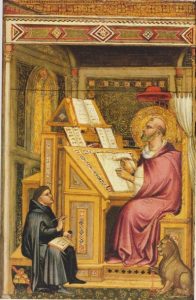
 4 5
4 5
This small picture of Saint Jerome copying a sacred text in the presence of the lawyer Ridolfi appears to herald a change of paradigm in the way imagery of saint Jerome is represented and marks one of the earliest examples of Saint Jerome in his study as defined by the famous Bolognese law professor Giovanni di Andrea (1270-1348). Hence our painting is one of the earliest, if not the earliest, Tuscan representation of this new typology, after representations by the Bolognese illuminator, Niccolo di Giacomo in 1353, in a manuscript with a text written exactly by Giovanni di Andrea himself (Biblioteca Vaticana, MS Vat. Lat. 145b fol.1) or in a leaf from Giovanni di Andrea’s decretals in the Fitzwilliam Museum in Cambridge Ms 331, fig.3b). Several later interpretations of this new iconography of the representation of Saint Jerome are known by the Master of San Jacopo a Mucciana, in the North Carolina Art Museum in Raleigh (ca. 1390-1400, Kress 102, fig.6), Benedetto di Bindo in The Johnson collection in Philadelphia (ca. 1400-1410, fig.7), and by Cenni di Francesco di Ser Cenni himself in San Miniato al Tedesco (dat.1411, fig.5), just to name a few.
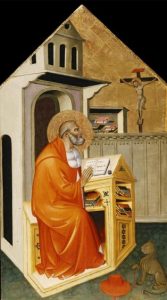
 6, 7
6, 7
The probable date for our painting (1380-85) corresponds with Boskovits’ proposal expressed some fifteen years ago. This moment marks a very delicate and in certain ways contradictory moment within Cenni’s artistic career, when he, in search of more refined models, decided momentarily to emancipate his style from the simplified orcagnesque formulas he had learned in Giovanni del Biondo’s workshop. Compared to his late interpretation of Saint Jerome in his study in San Miniato (fig.5, 10) and despite some undeniable conceptual similarities, there are, nevertheless, fundamental differences in our painting that mainly concern the painting’s spatial concept as well as certain characteristics relating to Cenni di Francesco di ser Cenni’s normal figural style. In Cenni di Francesco di ser Cenni’s version of Saint Jerome, created nearly three decades after our picture, the saint’s elongated and slender body seems to get lost in the intricacy of the desk’s architecture and the complex setting of the interior of the room which results in various levels of perspective. These are further echoed in the painting’s upper part, where our eyes are directed away from the protagonist towards the restless construction of a town’s buildings. The unsettled nature of this architectural setting, which embraces the Saint Jerome, ultimately distracts the viewer’s attention from

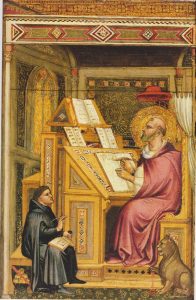
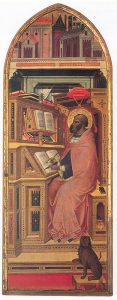 8 9 10
8 9 10
the saint and appears in sharp contrast to the quiet mood prevalent in our painting. In the case of Cenni di Francesco di ser Cenni’s additive compositional concept, the venerated saint appears to be buried between numerous books and the towering furniture, whereas in his earlier interpretation and in harmony with the subject’s intention, we sense a feeling of peace and quiet intellectual activity. The transmission of a sense of tranquillity is obviously produced on the one hand by the clear and harmonious spatial concept and on the other by the figure’s rational integration into this lovingly rendered space of a richly ornamented writing chamber in the style of a private library in a wealthy Florentine Palazzo. We may discern similar artistic tendencies towards a more rational spatial concept in Cenni di Francesco di ser Cenni’s paintings created in the years around 1380, such as in the truly beautiful Saint Catherine of Alexandria in the Metropolitan Museum in New York, which can be dated around 1380-85. Despite the overwhelming profusion of detailed architectural motifs of considerable refinement, the iconic presence of the Saint is in no way belittled in this fine picture. Much in the same way as in our little painting of Saint Jerome, Cenni di Francesco di ser Cenni focussed all his efforts in order to enhance the physical presence of his protagonist. At the same time we note that in the figures’ faces in our diptych all the abstract and simplified formulas, characteristic to Cenni di Francesco di ser Cenni, ultimately acquired from the models of Giovanni del Biondo, are somewhat decreased and gave way to more voluminous physiognomies, which are full of emotional energy.

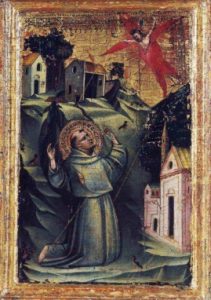
 11 12 13
11 12 13
At this particular moment of his career Cenni di Francesco di ser Cenni reveals himself as an artist capable of creating in his scenes a refined sense of atmosphere. In the case the present Saint Jerome in his scriptorium this is achieved by means of an introverted meditative spirit that unfolds in a wonderful softly lit dim room suffused in a warm golden light; in the companion panel dedicated to Saint Francis it is by the dreamy light emitted by the miraculous appearance of the Saviour, disguised as seraphim, emanating from the Stigmas to Saint Francis. The rocky scenery and the few buildings scattered there, as well as the saint himself, are drenched in this warm mystical light. Similar luminous effects night scenes clearly appear to pervade Taddeo Gaddi’s nocturns; for instance in the scene of the Annunciation to the shepherds in the Baroncelli chapel in Santa Croce in Florence or, even more clearly related to our case, in the fresco of The Stigmatization of San Francis in the Refectory of the same convent (fig.13). These sophisticated effects of light and shades, invented by Taddeo Gaddi, were not only a source of inspiration for our painter, but also had a disseminal effect upon the later generation of painters, such as Gentile da Fabriano, for instance, in his later interpretation of the same scene in the painting in the collection of the Fondazione Magnani Rocca in Traversetolo (Parma). On this occasion Gentile even introduced the spectacular effect of figures and objects casting their shadows. A comparison between our Stigmatisation of Saint Francis with Taddeo Gaddis interpretation of the same subject in Santa Croce (c.1360) clearly reveals the subtle attention paid to the elder painter’s invention. The compositional setting of a rocky landscape, with a canyon linked by a little wooden bridge leading at both ends to two oratories built on top of both rocky hills, appears as a clear derivation from Taddeo’s model. Even the architecture is painstakingly drawn one to one from Taddeo’s fresco. Hence, it becomes rather clear where Cenni’s eyes were turned during this particular period of his career. However, there is littledoubt that Taddeo Gaddi’s authority was not the only component in his art, as he had trained within the orcagnesque workshop of Giovanni del Biondo. It appears that Cenni was also well aware of the multicultural artistic developments in Florence in the third quarter of the 14th century, particularly of those more naturalistic currents introduced to Florence by either native Florentines with working experience in the region of Lombardy, such as Stefano Fiorentino, or directly by Northern Italian artists, such as Giovanni da Milano, a key figure and a highly important source of inspiration for our painter. Giovanni da Milano introduced to Florence a new perception of naturalism, not only with regard to the luminous modelling of the figures but also as applied to a naturalistic rendering of things. This is clearly visible in Giovanni da Milano’s paintings where he introduced a new sense for tactile values and a convincing naturalistic rendering of the tangible world of meticulously painted wooden thrones of great elegance. Such furniture is embellished with orientalising intarsia with rich Cosmati-style patterns, such as the wooden desk, lecterns etc., which may be seen in his many enthroned Madonnas and also in paintings which relate to ours such as the charming scene of Saint Bernard of Clairvaux writing down the words dictated to him by the Virgin, from the giant altarpiece painted around 1355-60 for the Ospedale della Misericordia in Prato (Prato Museo Civico, fig.4, 14 reversed view). It seems that it is the painterly world of Giovanni da Milano and the Florentine followers of Giotto, active in Lombardy, particularly Giusto de’ Menabuoi, that must have provided our artist with an important source of inspiration when he was confronted with the task of inventing a scene of Saint Jerome according to the new canon established by Giovanni di Andrea. This becomes evident if we compare the elaborate study of Saint Jerome, furnished with richly intarsiated furniture, with Giovanni da Milano’s Saint Bernard of Clairvaux from the Prato altarpiece (fig.15 reversed view) or – no less evident – with the studiolo of a church father in the Abbazia of Viboldone, painted by the Florentine Giusto de’ Menabuoi, who had emigrated to the Lombardy region, (fig.16, reversed view).

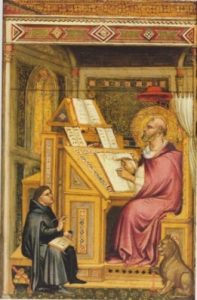
 14 15 16
14 15 16
Just how well acquainted our painter must have been with Giovanni da Milano is further revealed by the choice of similar ornaments, as documented by a comparison of one of the golden ornaments of a quatrefoil in the green wall behind Saint Jerome (fig.17), with another of similar shape and quality in the garment of Saint Lawrence from Giovanni’s Ognissanti altarpiece (Florence Uffizi, fig.18). As we will discuss below, this workshop relation between the painters is further documented by the common use of the same punching tool to decorate the gold ground of some of their paintings (fig.19, 20, 21)

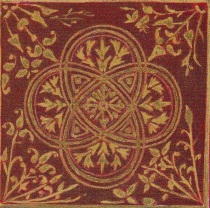 17 18
17 18
Cenni di Francesco di ser Cenni’s ties to this particular artist must have been sufficiently close to warrant even having had access to the punching tools used by the Lombard painter. As a matter of fact the tooled golden stripe in the frame of the upper section of the Ridolfi panels (fig.21) is carried out with the same tooling instrument used by Giovanni da Milano, only on the occasion when, probably in the 1350s, he had embellished the inner frame of his splendid Imago Pietatis painted for a member of the Pisan family Fioravante in a French private collection (fig.19, 20).
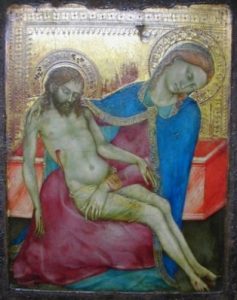
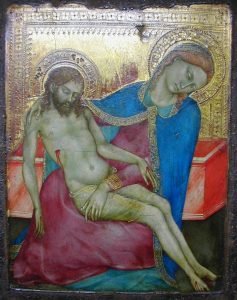
 19 20 21
19 20 21
This tool was not among one of those of Sienese origin, apparently brought by Giovanni da Milano to Florence around 1362, which were subsequently shared by Florentine painters (E. Skaug, in: D. Parenti (ed.) Giovanni da Milano, exh.cat. Florence 2008, pp. 103-113). This is indicative of a closer artistic bond with Giovanni da Milano than had originally been envisaged. This awareness of Giovanni da Milano’s art might have determined Cenni di Francesco di ser Cenni’s taste for gothic forms, as they would appear in a growing measure in his later works after 1385. Our picture then marks a watershed in Cenni di Francesco di ser Cenni’s career at a time when he momentarily abandons some of his typical artistic formulas in favour of a more experimental art. This moment, 1380-85, defines a body of works which have been seen by past critics as an oeuvre distinct from Cenni’s works. These works were then labelled under such phantomatical names as The Master of the Kahn Catherine or The Master of the Rohoncz Madonna, but later convincingly returned by Miklòs Boskovits and others to Cenni di Francesco di ser Cenni’s body of works datable around 1380-85 (Miklòs Boskovits, The Thyssen Bornemisza Collection : Early Italian Painting, 1299-1470, London 1990, p. 54-57).
There can be no doubt that, by 1380, Cenni di Francesco di ser Cenni must have been well established in Florence in order to have become eligible to paint a diptych for a patron as prominent as Lorenzo di Antonio Ridolfi. Undoubtedly, the inclusion of Ridolfi, the patron, in his diptych as scribe to Saint Jerome and consequently venerated in his own picture, makes this picture an important herald for a new intellectual spirit and the growing civic pride in Florence at the dawn of the Renaissance. These values mark the importance of this diptych as a truly significant document of Florentine history and culture on the threshold to the Renaissance.
Gaudenz Freuler
London, Wildenstein
Paris, Private collection
G. Sarti, Primitifs et Maniéristes Italiens (1370-1570), Paris 2000, pp. 14-22.
Eliot W. Rowlands, Masaccio, Saint Andrew and The Pisa Altarpiece (Los Angeles, Getty Publications, 2003, p.71, fig.63.
Gaudenz Freuler, ‘Eine Florentinischer Trecento-Tafel Mit Dem Heilegen Hieronymus’ in Der Schreibstube, in Licht räme : Festschrift fur Brigitte Kurmann-Schwarz, 2016, pp.56-64, ill.Fig.1.

